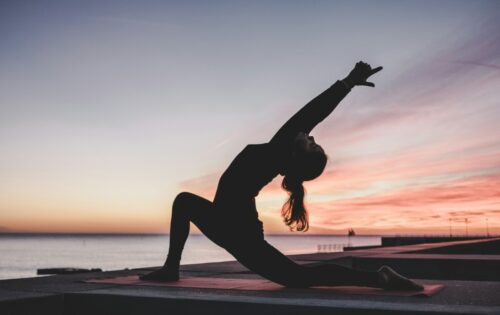Yoga, an ancient practice with roots in Indian philosophy, has evolved over millennia. It has adapted to various cultures and lifestyles while maintaining its core essence of harmonizing the body, mind, and spirit. This versatile practice, incorporating elements like meditation, breathing exercises, and physical postures, is lauded for its multifaceted health benefits.
Different Styles of Yoga and Their Health Benefits
1. Hatha Yoga
Hatha Yoga, often a gentle introduction to yoga, focuses on basic postures at a slow and steady pace. This yoga is ideal for beginners. It is the foundation upon which many other yoga styles are built. This technique emphasizes physical and mental strength and flexibility through a combination of asanas and breathing techniques.
Regular practice of Hatha Yoga enhances physical attributes like flexibility, balance, and core strength and plays a crucial role in mental well-being. It’s known for reducing stress and anxiety, promoting a tranquil state of mind. Furthermore, Hatha Yoga’s gentle nature suits individuals of all ages and fitness levels. This includes those recovering from injuries or dealing with chronic conditions.
2. Vinyasa Yoga
Vinyasa Yoga, sometimes referred to as “flow yoga,” is characterized by its dynamic and flowing nature. This style links breath with movement, creating a seamless dance-like sequence of poses. The pace can vary, but the emphasis on smooth transitions and motion remains constant, offering a more physically demanding form of yoga.
Ideal for those seeking an invigorating workout, Vinyasa Yoga boosts cardiovascular health, builds muscle strength, and enhances endurance. Its rhythmic nature elevates physical fitness and helps cultivate concentration and mental focus. Vinyasa’s adaptability caters to various fitness levels, making it popular in fitness centers and yoga studios.
3. Ashtanga Yoga
Ashtanga Yoga is a rigorous style characterized by six established and progressive series of poses synchronized with breath. The movements are precise, and the practice is often done in a set sequence, making it both challenging and rewarding for practitioners.
Ashtanga Yoga is excellent for building physical strength, stamina, and flexibility. The intensity of the practice provides a cardiovascular benefit, while the disciplined nature of the sequences fosters mental focus and determination. Regular Ashtanga practice can also enhance body awareness and control, promoting an overall sense of well-being.
4. Iyengar Yoga
Iyengar Yoga is a form of yoga that places significant emphasis on precision and alignment in the execution of postures. Props like blocks, belts, and bolsters are a hallmark of this style. They aid practitioners in achieving correct alignment and deeper engagement in the poses.
This yoga style is particularly beneficial for those seeking to improve posture and alignment. This yoga style can alleviate various physical ailments, from back pain to joint issues. Its methodical approach is excellent for beginners and those with specific physical limitations. The focus on alignment and detail also encourages a deeper internal awareness and mind-body connection.
5. Bikram/Hot Yoga
Bikram Yoga, developed by Bikram Choudhury, consists of 26 postures and two breathing exercises performed in a room heated to about 105°F with 40% humidity. The heat warms the muscles and aids in flexibility, making it a vigorous style of yoga.
Practicing in a heated environment enhances flexibility and aids in the detoxification process through sweating. Bikram Yoga also boosts circulation, aids in weight loss by increasing heart rate, and can improve skin health. The repetitive nature of the sequences allows practitioners to monitor their progress over time.
6. Restorative Yoga
Restorative Yoga is a passive, meditative form of yoga that aims to bring the body into deep relaxation and healing. It involves using props to support the body in various postures, allowing for complete relaxation and letting go of tension.
This style is particularly beneficial for those seeking stress relief and mental relaxation. It can improve sleep quality, enhance flexibility at a gentle pace, and is often used as a therapeutic tool for recovering from illness or injury. The meditative aspect of Restorative Yoga also aids in cultivating mindfulness and a deeper sense of inner peace.

Incorporating Yoga into a Busy Lifestyle
- Flexibility in Practice: One of the beauties of yoga is its flexibility – not just in the physical sense but also in how it can be adapted to fit into any schedule. With various styles, there’s a form of yoga for every time and energy level.
- Creating a Personalized Yoga Routine: It’s important to listen to your body and mind and choose a style that suits your current needs. This might mean a quick Vinyasa flow in the morning to energize for the day ahead. Or a soothing Restorative session in the evening to wind down.
- Incorporating Yoga at Work: Integrating short yoga breaks throughout the day can significantly impact physical and mental health for those with desk jobs. Simple stretches, breathing exercises, or even chair yoga can combat the stiffness and stress associated with prolonged sitting.
- Yoga for Family and Social Activity: Yoga can also be a social activity. Attending a class with a friend or practicing yoga with family members makes it a fun, engaging experience and helps maintain consistency.
- Setting Achievable Goals: It’s essential to set realistic goals and be patient with your progress. Remember, yoga is not about competition or perfection, but about the journey towards greater health and harmony within oneself.
- Embracing the Holistic Nature of Yoga: Finally, remember that yoga is more than just physical postures; it’s a holistic practice that encompasses mental and spiritual well-being. Incorporating aspects of meditation and mindfulness into your routine can significantly enhance the benefits of the physical practice.
Incorporating yoga into a busy lifestyle doesn’t require drastic changes. Rather, it’s about finding small, manageable ways to include this practice into your daily routine. Whether it’s a few minutes of breathing exercises or a full yoga class, the key is consistency and mindfulness. With its wide range of styles and benefits, yoga offers a versatile tool for improving overall health and well-being. Yoga is suitable for individuals from all walks of life.
